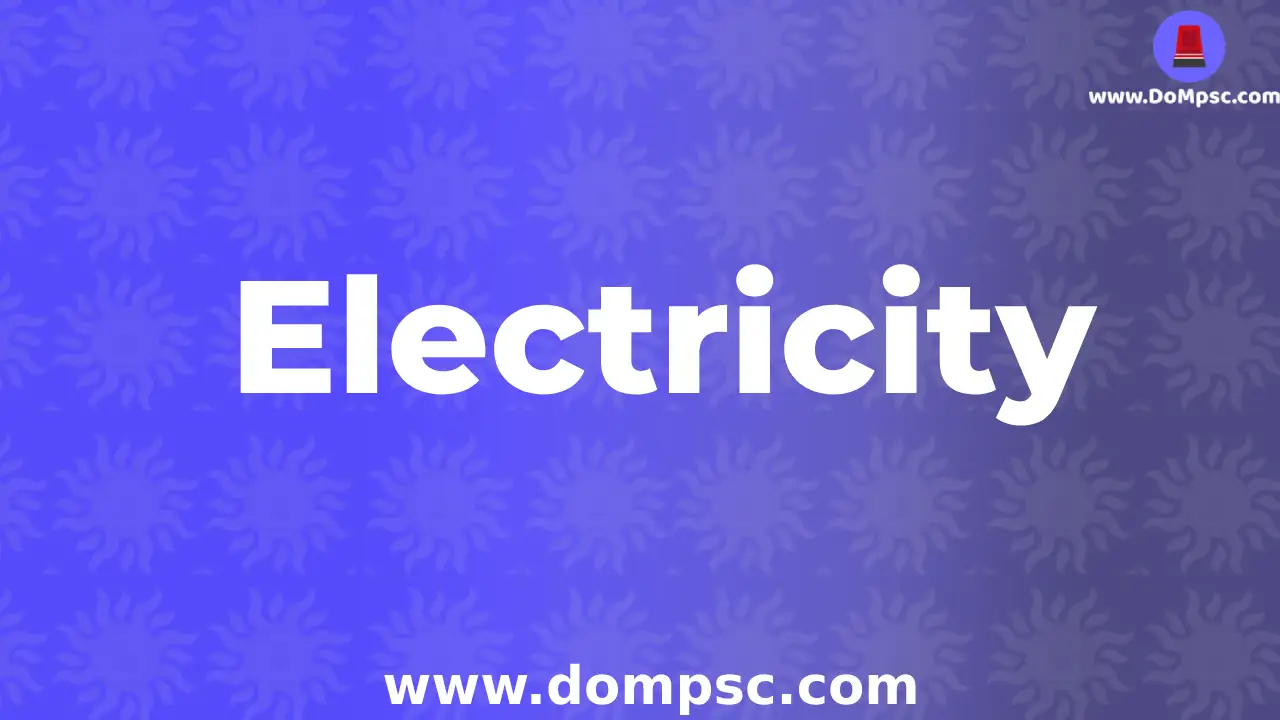Electricity(विद्युतधारा)-mpsc science

✪ Download pdf Works Properly on chrome Browser ✪
Table Of Contain-Electricity(विद्युतधारा)
Intro of Electricity(विद्युतधारा)

By Shubham Vyawahare
0-May-2025
➤Those Electrons are knows as Free Electrons
➤These Free Electrons are moved from one side to other in electronic conductor.
➤so current can be defined as the flow of moving of electron in the particular area.
➤I=Q/T
➤ Q= is Charge and T= is Time
➤Unit of electric charge is coulomb(C)
➤Current measure in Ampere which is 1 Coulomb / 1 Second
Electric Circuit
➤ A circuit is a closed loop or a path that forms a network of electronic components in which electrons can flow. .
➤ The path is made of wires and is powered by a power source (such as a battery).
➤ The point where the electrons begin to flow is called the source, and the point where the electrons leave the circuit is called the return.
Simple Circuit
➤ A simple circuit comprises the power source, conductors, switch, and load.
➤ Cell: It is the power source.
➤ Load: It is also termed as the resistor. It is a light bulb that lights when the circuit is turned on.
➤ Conductors: They are made of copper wires with no insulation. One end of the wire is connected the load to the power source and the other end of the wire connects the power source back to the load.
➤ Switch: It is a small gap in the circuit. There are various types of switches. A switch can be used to open or close a circuit.
Potential Difference
➤potential difference is the difference in the amount of potential energy a particle has due to its position between two locations in an electric field.It is the energy difference that tends to make an electric charge or current move. It is measured in volts.
➤ P.D.=Work / Charged Which has Transfer
➤V=W /Q
➤V=J/C
➤ SI Unit of P.D is Volt
Resistance
➤Resistance is a measure of the opposition to current flow in an electrical circuit.
➤ Resistance is measured in ohms, symbolized by the Greek letter omega (Ω)
➤ Conductors Materials that offer very little resistance where electrons can move easily. Examples: silver, copper, gold and aluminum.
➤ Insulators Materials that present high resistance and restrict the flow of electrons. Examples: Rubber, paper, glass, wood and plastic.
➤ The higher the resistance, the lower the current flow. If abnormally high, one possible cause (among many) could be damaged conductors due to burning or corrosion. All conductors give off some degree of heat, so overheating is an issue often associated with resistance.
➤ Many components, such as heating elements and resistors, have a fixed-resistance value. These values are often printed on the components' nameplates or in manuals for reference.
➤ Resistance" may sound negative, but in electricity it can be used beneficially.
➤ R=V/I
Ohm Law Of Electricity
➤Ohm Law Of Electricity is a formula used to calculate the relationship between voltage, current and resistance in an electrical circuit.
➤ Ohm’s principal discovery was that the amount of electric current through a metal conductor in a circuit is directly proportional to the voltage impressed across it, for any given temperature
➤ V=IR
Resistivity
➤ Resistivity is a measure of the resistance of a given size of a specific material to electrical conduction.
➤Resistivity may also be referred to as the specific electrical resistance, or volume resistivity, although these terms are less widely used.
➤ Although materials resist the flow of electrical current, some are better at conducting it than others.
➤ The resistivity is a figure that enables comparisons of the way in which different materials allow or resist current flow.
➤R=Q I/ A
➤ I=Length of conductor and Q=Constant
➤ Unit of Resistivity is Ohm-Meter
Joule LAw
➤ Joule's law of heating states that, when a current 'i ' passes through a conductor of resistance 'r' for time 't' then the heat developed in the conductor is equal to the product of the square of the current, the resistance and time.
➤ H=I^2 Rt / 4.18
Others Blogs Related to MPSC Science Notes
Read All MPSC blogs
- ➤केंद्र सरकारने खाजगी क्लासेस साठी नवी नियमावली लागू केली आहे |GUIDELINES FOR REGULATION OF COACHING CENTER in marathi
- ➤MPSC Data leak: पेपर न फुटल्याचा दावा MPSC आयोगाने स्पष्टपणे केला आहे
- ➤MPSC hall ticket data leaked before 6 days of exam
- ➤MPSC Data leak: टेलेग्राम वर अचानक ९० हजार परीक्षार्थींचे प्रवेशपत्र झाले लिक
- ➤मराठी भाषेला अभिजात दर्जा मिळायला हवाच , अभिजात दर्जा नेमका कसा मिळतो ?
Download MPSC Books pdf



